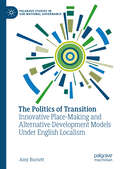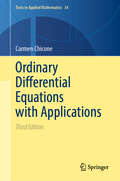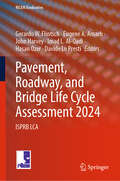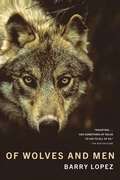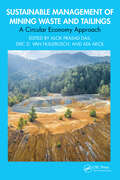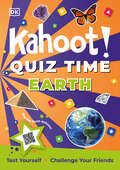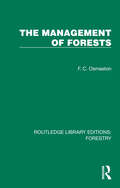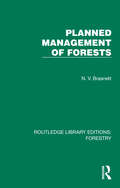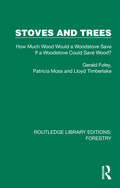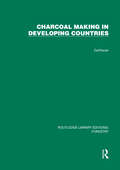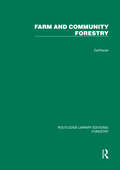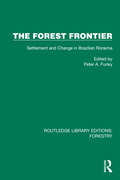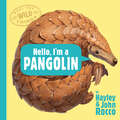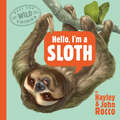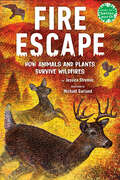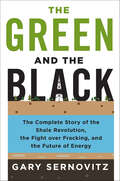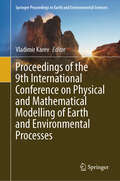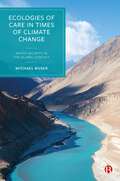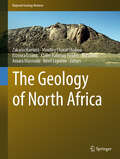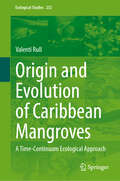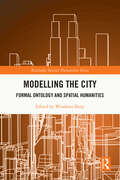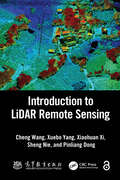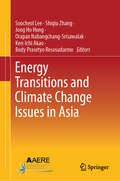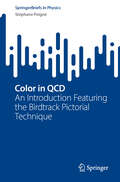- Table View
- List View
The Politics of Transition: Innovative Place-Making and Alternative Development Models Under English Localism (Palgrave Studies in Sub-National Governance)
by Amy BurnettThis book explores the impact of recent planning reforms on emergent, alternative models of local governance. It uses the pioneering approach of Frome in Somerset, UK to showcase development and governance alternatives in a post-Brexit landscape. It investigates the role of planning in contributing to sustainable development under localism, and examines how key actors have used the Neighbourhood Planning process to put forward niche, community-based development futures. In doing so, the book offers valuable methodological, empirical and theoretical contributions to wider debates concerning transition, placemaking, local politics and planning. It will appeal to all those interested in public policy and governance.
Ordinary Differential Equations with Applications (Texts in Applied Mathematics #34)
by Carmen ChiconeThis book, developed during 20 years of the author teaching differential equations courses at his home university, is designed to serve as a text for a graduate level course focused on the central theory of the subject with attention paid to applications and connections to other advanced topics in mathematics. Core theory includes local existence and uniqueness, the phase plane, Poincaré-Bendixson theory, Lyapunov and linearized stability, linear systems, Floquet theory, the Grobman–Hartman theorem, persistence of rest points and periodic orbits, the stable and center manifold theorems, and bifurcation theory. This edition includes expanded treatment of deterministic chaos, perturbation theory for periodic solutions, boundary value problems, optimization, and a wide range of their applications. In addition, it contains a formulation and new proof of a theorem on instability of rest points in the presence of an eigenvalue with positive real part, and new proofs of differential inequalities and Lyapunov’s center theorem. New sections present discussions of global bifurcation, the Crandall–Rabinowitz theorem, and Alekseev’s formula. Of particular note is a new chapter on basic control theory, a discussion of optimal control, and a proof of a useful special case of the maximum principle. A key feature of earlier editions, a wide selection of original exercises, is respected in this edition with the inclusion of a wealth of new exercises. Reviews of the first edition:“As an applied mathematics text on linear and nonlinear equations, the book by Chicone is written with stimulating enthusiasm. It will certainly appeal to many students and researchers.”—F. Verhulst, SIAM Review “The author writes lucidly and in an engaging conversational style. His book is wide-ranging in its subject matter, thorough in its presentation, and written at a generally high level of generality, detail, and rigor.”—D. S. Shafer, Mathematical Reviews
Pavement, Roadway, and Bridge Life Cycle Assessment 2024: ISPRB LCA (RILEM Bookseries #51)
by John Harvey Imad L. Al-Qadi Hasan Ozer Gerardo W. Flintsch Eugene A. Amarh Davide Lo PrestiThis book highlights the latest advances, innovations, and applications in the field of LCA in pavements, bridges, and roadways, as presented by leading international researchers at the 6th International Symposium on Pavement, Roadway, and Bridge Life Cycle Assessment (ISPRB LCA2024), held in Arlington, VA, USA, on June 6–8, 2024. It covers a diverse range of topics concerning assessment of environmental impacts of pavements, bridges, and roadways, including environmental product declarations (EPDs) and use of life cycle assessment (LCA) in design, data, and case studies: LCA methodologies for transportation infrastructure, durability and service life assessments, maintenance strategies to enhance performance and minimize environmental impacts, evaluating the environmental impacts of materials and construction, recycling and reuse of materials, carbonation of concrete, pavement vehicle interaction, life cycle thinking in climate change planning, and climate change mitigation. The contributions, which were selected by means of a rigorous international peer-review process, present a wealth of exciting ideas that will open novel research directions and foster new multidisciplinary collaborations.
Of Wolves and Men
by Barry LopezOriginally published in 1978, this classic exploration of humanity&’s complex relationship with and understanding of wolves returns with a new afterword by the author.Humankind's relationship with the wolf is the sum of a spectrum of responses ranging from fear to admiration and affection. Lopez&’s classic, careful study has won praise from a wide range of reviewers and improved the way books on wild animals are written. Of Wolves and Men explores the uneasy interaction between wolves and civilization over the centuries, and the wolf's prominence in our thoughts about wild creatures. Drawing upon an impressive array of literature, history, science, and mythology as well as extensive personal experience with captive and free-ranging wolves, Lopez argues for the wolf's preservation and immerses the reader in its sensory world, creating a compelling portrait of the wolf both as a real animal and as imagined by different kinds of men. A scientist might perceive the wolf as defined by research data, while an Eskimo hunter sees a family provider much like himself. For many Native Americans the wolf is also a spiritual symbol, a respected animal that can strengthen the individual and the community. With irresistible charm and elegance, Of Wolves and Men celebrates careful scientific fieldwork, dispels folklore that has enabled the Western mind to demonize wolves, explains myths, and honors indigenous traditions, allowing us to understand how this remarkable animal has become so prominent for so long in the human heart.
Sustainable Management of Mining Waste and Tailings: A Circular Economy Approach
by Eric D. van Hullebusch Alok Prasad Das Ata AkçilIntegrating waste management, environmental sustainability, and economic development is a prime milestone in the circular economy. Critical metals recovery from mining tailings and secondary resources has significant potential, with widespread applications in high-tech industries that are critical to modern society and sustainable development. This book discusses technological advances for managing industrial and mining waste through circular economy approaches and successful critical metal recovery from secondary resources. It highlights how reprocessing of mine waste and tailings results in development of critical raw materials that significantly reduce the mining burden and ensure the lucrative use of waste materials.Features: Describes advances in remediation and valorization technologies for mining wastes Details biotechnological methods, cutting edge research, and applications Covers use of waste mining resources for economic growth and novel opportunities Discusses IR4.0 and machine learning methods Includes reports and case studies on mining waste in value-added products and recovery of strategically important critical minerals This book will be of value to researchers and advanced students working in the mining, chemical and environmental engineering, and renewable energy sectors.
Kahoot! Quiz Time Earth: Test Yourself Challenge Your Friends (Kahoot! Quiz Time)
by DKMore than 250 trivia questions for curious minds!What is the highest mountain in the world? What is the Earth’s core made of? Find out in this quiz book, packed with questions and facts about Planet Earth. Challenge yourself, your family, and friends with awesome questions based on the award-winning online Kahoot! games. Answer the questions, keep score, and declare the winner. Scan the QR codes throughout the book to find more cool quizzes on the same topics within Kahoot! and test your knowledge further. Go for gold and make learning awesome!Kahoot! and the K! logo are trademarks of Kahoot! AS.
The Management of Forests (Routledge Library Editions: Forestry)
by F. C. OsmastonOriginally published in 1968, this book discusses the principles and methods on which forest management has been founded in the past and how these principles and methods still apply or are affected by modern management skills, changing demands, social habits and resources. The book is concerned mainly with the technical aspects of forestry and the classic foundations of management. To a lesser degree it deals with commercial efficiency, labour relations and the implications of these. The historical chapter shows the tends in the development of forestry, particularly in Europe.
Planned Management of Forests (Routledge Library Editions: Forestry)
by N. V. BrasnettOriginally published in 1953, this book was compiled to provide students of forestry with a simple outline of what the management of forests involves, and of the way in which forestry operations are organized and controlled. Topics discussed and explained include economic considerations, stock mapping, topography, climate, soils, form and distribution of crops, scientific forestry, destruction of forests, regulation by volume, area and size and forest protection.
Stoves and Trees: How Much Wood Would a Woodstove Save If a Woodstove Could Save Wood? (Routledge Library Editions: Forestry)
by Lloyd Timberlake Gerald Foley Patricia MossOriginally published in 1984, Stoves and Trees asks whether better stoves really help the two billion people in the developing world who rely on wood and charcoal for cooking and heating their homes. It also asks if improved stoves actually save fuel and if they can help slow down tropical deforestation. The book not only examines newer stoves but also ascertains how people buy, collect and use wood in the developing world. It finds that most forests are cleared for timber or farmland not fuelwood and explains why stoves which show 50% energy savings in European laboratories often save little or none in village homes.
Charcoal Making in Developing Countries (Routledge Library Editions: Forestry)
by Gerald FoleyOriginally published in 1986, this book provides a detailed examination of programmes to introduce improved charcoal making techniques throughout the developing world. Charcoal making is widely regarded as an extremely wasteful use of scarce wood resources. The book includes a section on the physics and chemistry of charcoal and descriptions of the various traditional methods of charcoal making. Patterns of charcoal supply and distribution are analysed and efforts to introduce improved charcoal making techniques are described and evaluated.
Farm and Comunity Forestry (Routledge Library Editions: Forestry)
by Gerald Foley Geoffrey BarnardIn 1984, when this book was originally published the need to take forestry outside the forests and involve local people in tree growing was widely recognised. Projects to encourage farm and community forestry were launched in over 50 developing countries. This book describes the main approaches which were taken, discussing their scope and limitation. It examines the reasons why people plant trees, and the constraints which prevent them from doing so. It analyses supply and demand systems for wood, and the underlying forces causing tree depletion. Key aspects of programme design and implementation are also covered, including technical problems, the role of extension services and programme planning requirements.
The Forest Frontier: Settlement and Change in Brazilian Roraima (Routledge Library Editions: Forestry)
by Peter A. FurleyOriginally published in 1994, this book analysed land developments, deforestation and pasture substitution, colonisation schemes and spontaneous settlement during the latter part of the 20th Century. In so doing, The Forest Frontier presents an overview of the intrinsic environmental and socio-economic resources of the Roraima, the most northerly of the Brazilian Amazon states. Roraima is of special environmental interest because of its extensive savannas and varied forests – the home of some of the largest and most diverse groups of indigenous Indians. This critical assessment of the nature and pace of agricultural advance into Roraima examines the range of strategies which have been proposed to cope with the inevitable development. With the conflict between preserving the natural environment and development still major issues for Brazil, this book remains as relevant now as when it was first published.
Hello, I'm a Pangolin (Meet the Wild Things #2)
by Hayley RoccoSay hello to a pangolin, and learn all about this incredible endangered species—and why they need protecting—in this clever, funny, and informative nonfiction picture book, illustrated by a Caldecott Honoree.&“Wild, fun, and truly eye-opening, Meet the Wild Things gets us up close and personal with some of the world's most amazing creatures. With this series, Hayley and John Rocco are doing more than entertaining our kids—they&’re inspiring them to care about the future of our planet.&” —Brad Meltzer, bestselling author of the Ordinary People Change the World seriesDid you know pangolins are the only mammals with scales? Not even the teeth of a lion can break through their tough armor.And did you know pangolins have a super-sticky tongue as long as their entire body? (The better to eat 20,000 bugs a day with!)Chock-full of amazing, kid-friendly facts and inviting artwork from the #1 New York Times bestselling illustrator of Blackout, the Meet the Wild Things series introduces young readers to endangered animals from around the globe, told from the points of view of the animals themselves.
Hello, I'm a Sloth (Meet the Wild Things #1)
by Hayley RoccoSay hello to a sloth, and learn all about this incredible endangered species—and why they need protecting—in this clever, funny, and informative nonfiction picture book, illustrated by a Caldecott Honoree.&“Wild, fun, and truly eye-opening, Meet the Wild Things gets us up close and personal with some of the world's most amazing creatures. With this series, Hayley and John Rocco are doing more than entertaining our kids—they&’re inspiring them to care about the future of our planet.&” —Brad Meltzer, bestselling author of the Ordinary People Change the World seriesDid you know sloths only poop once a week?Or that they can fall up to 100 feet without getting hurt?They have hundreds of bugs living on them, including a species of moths that only lives on sloths!And they move so slowly that algae grows on their fur, which—far from being gross—can actually help sloths by camouflaging them from predators.Chock-full of amazing, kid-friendly facts and inviting artwork from the #1 New York Times bestselling illustrator of Blackout, the Meet the Wild Things series introduces young readers to endangered animals from around the globe, told from the points of view of the animals themselves.
Becoming Earth: How Our Planet Came to Life
by Ferris JabrA vivid account of a major shift in how we understand Earth, from an exceptionally talented new voice. Earth is not simply an inanimate planet on which life evolved, but rather a planet that came to life.One of humanity&’s oldest beliefs is that our world is alive. Though once ridiculed by some scientists, the idea of Earth as a vast interconnected living system has gained acceptance in recent decades. We, and all living things, are more than inhabitants of Earth—we are Earth, an outgrowth of its structure and an engine of its evolution. Life and its environment have coevolved for billions of years, transforming a lump of orbiting rock into a cosmic oasis—a planet that breathes, metabolizes, and regulates its climate.Acclaimed science writer Ferris Jabr reveals a radical new vision of Earth where lush forests spew water, pollen, and bacteria to summon rain; giant animals engineer the very landscapes they roam; microbes chew rock to shape continents; and microscopic plankton, some as glittering as carved jewels, remake the air and sea.Humans are one of the most extreme examples of life transforming Earth. Through fossil fuel consumption, agriculture, and pollution, we have altered more layers of the planet in less time than any other species, pushing Earth into a crisis. But we are also uniquely able to understand and protect the planet&’s wondrous ecology and self-stabilizing processes. Jabr introduces us to a diverse cast of fascinating people who have devoted themselves to this vital work.Becoming Earth is an exhilarating journey through the hidden workings of our planetary symphony—its players, its instruments, and the music of life that emerges—and an invitation to reexamine our place in it. How well we play our part will determine what kind of Earth our descendants inherit for millennia to come.
Fire Escape: How Animals and Plants Survive Wildfires (Books for a Better Earth)
by Jessica StremerA timely middle grade nonfiction overview of the incredible ways animals detect, respond, and adapt to wildfires, as well as how climate change is affecting the frequency and severity of these devastating events in nature.Goats and beavers. Drones and parachutes. Pinecones and beetles. What do they have in common? Believe it or not, they are all crucial tools in fighting, preventing, and adapting to wildfires!These vicious fires are spreading faster and burning hotter than at any other time in history. Ongoing droughts, warming weather, and a history of poor forest management have extended the traditional wildfire season beyond the summer months. It is a matter of life and death for wildlife worldwide.This breathtaking nonfiction book focuses on unique angles to a hot topic, including injury rehabilitation efforts, species that use wildfires to their advantage, how to help area repopulation, and the animals that help to prevent/fight wildfires. A riveting, kid friendly text is accompanied by stunning woodcut illustrations and full-color photographs, as well as extensive back matter with glossary, sources, and index.Books for a Better Earth are designed to inspire children to become active, knowledgeable participants in caring for the planet they live on.A Junior Library Guild Gold Standard Selection
The Green and the Black: The Complete Story of the Shale Revolution, the Fight over Fracking, and the Future of Energy
by Gary SernovitzGary Sernovitz leads a double life. A typical New York liberal, he is also an oilman - a fact his left-leaning friends let slide until the word "fracking" entered popular parlance. "How can you frack?" they suddenly demanded, aghast. But for Sernovitz, the real question is, "What happens if we don't?"Fracking has become a four-letter word to environmentalists. But most people don't know what it means. In his fast-paced, funny, and lively book, Sernovitz explains the reality of fracking: what it is, how it can be made safer, and how the oil business works. He also tells the bigger story. Fracking was just one part of a shale revolution that shocked our assumptions about fueling America's future. The revolution has transformed the world with consequences for the oil industry, investors, environmentalists, political leaders, and anyone who lives in areas shaped by the shales, uses fossil fuels, or cares about the climate - in short, everyone. Thanks to American engineers' oilfield innovations, the United States is leading the world in reducing carbon emissions, has sparked a potential manufacturing renaissance, and may soon eliminate its dependence on foreign energy. Once again the largest oil and gas producer in the world, America has altered its balance of power with Russia and the Middle East.Yet the shale revolution has also caused local disruptions and pollution. It has prolonged the world's use of fossil fuels. Is there any way to reconcile the costs with the benefits of fracking?To do so, we must start by understanding fracking and the shale revolution in their totality. The Green and the Black bridges the gap in America's energy education. With an insider's firsthand knowledge and unprecedented clarity, Sernovitz introduces readers to the shales - a history-upturning "Internet of oil" - tells the stories of the shale revolution's essential characters, and addresses all the central controversies. To capture the economic, political, and environmental prizes, we need to adopt a balanced, informed perspective. We need to take the green with the black. Where we go from there is up to us.
Proceedings of the 9th International Conference on Physical and Mathematical Modelling of Earth and Environmental Processes (Springer Proceedings in Earth and Environmental Sciences)
by Vladimir KarevThis book presents short papers of participants of the 9th International Scientific Conference-School for Young Scientists «Physical and Mathematical Modeling of Earth and Environment Processes. A special focus is given to the extraction of hydrocarbon resources, including from unconventional sources. An alternative to the use of hydrocarbons as a main source of energy on the Planet in the coming decades is unlikely to be found. At the same time, the resource base of hydrocarbons is quickly depleted, in particularly, large and accessible oil and gas fields. The shale oil and gas, Arctic hydrocarbon stocks, gas hydrates, coal bed methane, oil and gas from deep horizons can become new sources. "Deep oil" may be the most promising source of expanding the resource base of hydrocarbons according to many experts. New technologies are required to their development. Efficient low-cost technologies can be created on the basis of geomechanical approach, i.e., through the use of a huge elastic energy stored in the rock massif due to rock pressure. The creation of new breakthrough approaches to the development of hydrocarbon fields is very important in today's geopolitical conditions and requires the involvement of young minds and strength. International activities, including the youth scientific schools, can become an effective tool for exchange of information and the organizing of interdisciplinary research of processes in geo-environment. The book presents the new results of the experimental and theoretical modeling of deformation, fracture, and filtration processes in the rocks in connection to issues of creating scientific fundamentals for new hydrocarbon production technologies. The investigations of the dependence of well stability and permeability of rocks on the stress-strain state in conditions of deep horizons and high rock pressure are also represented.
Ecologies of Care in Times of Climate Change: Water Security in the Global Context
by Michael BuserThis book investigates and analyses places in Europe, North America and Asia that are facing the immense challenges associated with climate change adaptation. Presenting real-world cases in the contexts of coastal change, drinking water and the cryosphere, Michael Buser shows how the concept of care can be applied to water security and climate adaptation. Exploring the everyday and often hidden ways in which water security is accomplished, the book demonstrates the pervasiveness and power of care to contribute to flourishing lives and communities in times of climate change.
The Geology of North Africa (Regional Geology Reviews)
by Ezzoura Errami Zakaria Hamimi Abdel-Rahman Fowler Moulley Charaf Chabou Nuri Fello Amara Masrouhi Rémi LeprêtreThis richly illustrated book reviews the geology, tectonics, sedimentary basins and strategic resources of North Africa in 21 chapters. Chapter 1 is a regional synthesis. Chapter 2 examines the deep crustal and upper mantle structure. Chapter 3 compares the West African Craton. Chapters 4,5,6,7 deal with Pan-African-, Variscan (Hercynian)- and Alpine-Belts. Precambrian Geology of Hoggar Shield, north Central Africa will be addressed in Chapter 8. The North African Neoproterozoic and Phanerozoic sedimentary basins are the topic of Chapter 9. Phanerozoic magmatism and geodynamic framework of North Africa are addressed in Chapter 10. Chapters 11,12 deal with petroleum geology and water resources. Important non-metallic- and metallic- ore deposits are presented in Chapter 13,14,15,16. Chapters 17,18 explore geothermal energy and other strategic resources. Chapters 19,20 discuss seismicity, seismotectonics and Neotectonics, and Advances of exploration geophysics in North Africa. The lasttwo chapters (20, 21) focus on meteoric impact craters, geoheritage, geoparks and geotourism in North Africa.
Origin and Evolution of Caribbean Mangroves: A Time-Continuum Ecological Approach (Ecological Studies #252)
by Valentí RullThis book provides a comprehensive, detailed, and coherent spatio-temporal account of Caribbean mangrove evolution from its evolutionary origins to the present that is not available for any mangrove region in the world. Mangroves are intertidal wetland forests that play a crucial role in the maintenance of terrestrial and marine biodiversity, and in the functioning of global biogeochemical cycles (especially the carbon cycle). These ecosystems dominate the tropical/subtropical coasts of all continents and are among the most threatened ecosystems in the world. This book combines all temporal scales, from the geological to the ecological, to provide an integrated picture of mangrove history and the natural and anthropogenic drivers of ecological and evolutionary change. This may be useful not only for understanding the current ecological status of these emblematic ecosystems, but also for informing their conservation in the face of ongoing global change.
Modelling the City: Formal Ontology and Spatial Humanities (Routledge Spatial Humanities Series)
by Wiesława DużyModelling the City focuses on European towns and cities, analysing the opportunities and limitations of modelling of urban space.This book examines how urban space from the past is discovered, explained and presented. It discusses the multitude of historical sources mediating the past urban space, and the structural, technical, and epistemological issues raised around building a domain ontology, including continuity, and change within urban forms and functions.Presentation of a formal domain ontology in spatial humanities makes this book unique and worth reading. It is strongly recommended to readers interested in the linked open data approach to research, data standards in Digital Humanities, urban planning, and old maps.
Introduction to LiDAR Remote Sensing
by Cheng Wang Pinliang Dong Xuebo Yang Xiaohuan Xi Sheng NieLight detection and ranging, or LiDAR, is an advanced active remote sensing technology developed in the last 30 years to measure variable distances to the Earth. This book explains the fundamental concepts of LiDAR technology and its extended spaceborne, airborne, terrestrial, mobile, and unmanned aerial vehicle (UAV) platforms. It addresses the challenges of massive LiDAR data intelligent processing, LiDAR software engineering, and in-depth applications. The theory and algorithms are integrated with multiple applications in a systematic way and with step-by-step instructions. Written for undergraduate and graduate students and practitioners in the field of LiDAR remote sensing, this book is a much-needed comprehensive resource.FEATURES Explains the fundamentals of LiDAR remote sensing, including theory, techniques, methods, and applications Highlights the dissemination and popularization of LiDAR remote sensing technology in the last decade Includes new advances in LiDAR data processing and applications Introduces new technologies such as spaceborne LiDAR and photon-counting LiDAR Provides multiple LiDAR application cases regarding topography mapping, forest investigation, power line inspection, building modeling, automatic driving, crop monitoring, indoor navigation, cultural heritage conservation, and underwater mapping This book is written for graduate and upper-level undergraduate students taking courses in remote sensing, geography, photogrammetric engineering, laser techniques, surveying and mapping, geographic information systems (GIS), forestry, and resources and environmental protection. It is also a comprehensive resource for researchers and scientists interested in learning techniques for collecting LiDAR remote sensing data and processing, analyzing, and managing LiDAR data for applications in forestry, surveying and mapping, cultural relic protection, and digital products.Chapters 1 and 2 of this book are freely available as a downloadable Open Access PDF at http://www.taylorfrancis.com under a Creative Commons Attribution-Non Commercial-No Derivatives (CC-BY-NC-ND) 4.0 license.
Energy Transitions and Climate Change Issues in Asia
by Soocheol Lee Ken-Ichi Akao Budy Prasetyo Resosudarmo Shiqiu Zhang Jong Ho Hong Orapan Nabangchang-SrisawalakThe rapid pace of economic development and urbanization in Asia have led to several major problems such as greenhouse gas emissions, mass consumption, and depletion of natural resources. These problems pose a major threat to a sustainable future for Asia and are hindering many Asian countries' goal of becoming carbon-neutral by the middle of this century. Solving these problems requires a comprehensive understanding of the nature of energy consumption, exploitation of natural resources, and deterioration of the environment.To accelerate the green energy transition and promote efficient resource use in Asia, a range of policy options and joint efforts among Asian countries will be required, including carbon pricing, resource tax reform, the expansion of transition finance, support for the development of low-carbon, and resource-efficient social infrastructure. However, Asia is home to many countries, each in a different stage of economic development and with its own culture and customs. Practical implementation of these policies will require bringing together researchers, policymakers, and citizens to share their knowledge and engage in discussions to generate policy ideas that are appropriate for each country. The purpose of this book is to share theoretical and empirical knowledge and convey policy implications that can be expected to accelerate energy transition and resource use effectiveness toward a sustainable future in Asia.
Color in QCD: An Introduction Featuring the Birdtrack Pictorial Technique (SpringerBriefs in Physics)
by Stéphane PeignéThis book introduces readers to the fascinating world of quantum chromodynamics (QCD) and quarks and gluons, the elementary constituents of protons, neutrons, and all hadrons. Specifically, it focuses on the color of quarks and gluons, responsible for their mutual interactions via the strong force. The book provides an elementary introduction to the birdtrack technique, which is a powerful tool for addressing the color structure of QCD in a pictorial way. The technique shows how quark and gluon colors are combined and mixed in QCD. The author discusses color conservation, shows how to project on color states of systems of quarks, antiquarks, and gluons, how to derive their color charges. The book is enriched with many exercises integrated in the text to learn by doing.This book is primarily intended for particle physics students, graduates, and researchers working in the field of QCD. However, it requires no specific prerequisites in QCD, so it may also be of interest to students of mathematics, as an illustration of the use of the birdtrack pictorial technique in representation theory.
